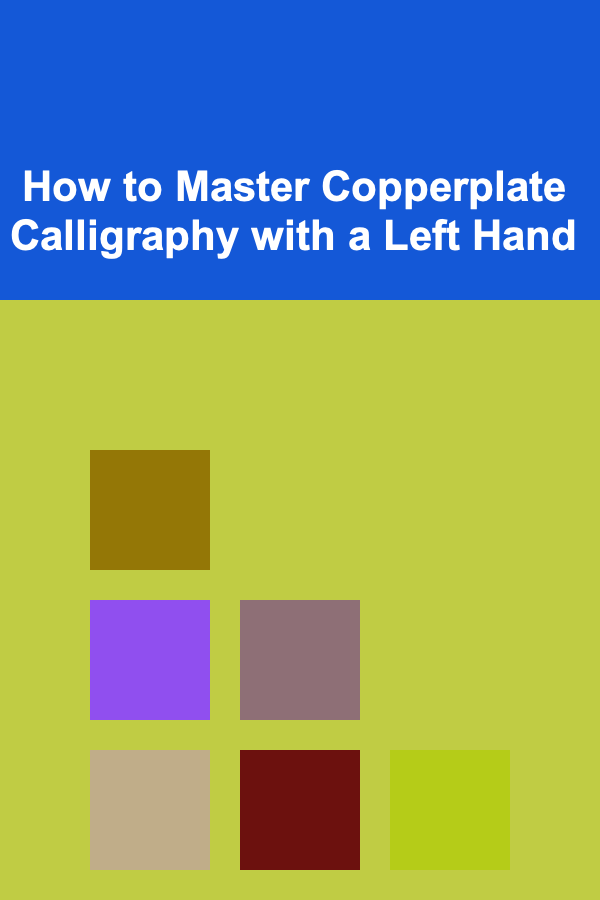
How to Master Copperplate Calligraphy with a Left Hand
ebook include PDF & Audio bundle (Micro Guide)
$12.99$8.99
Limited Time Offer! Order within the next:

Copperplate calligraphy, a beautiful and elegant script style, is often admired for its fluid, sweeping strokes and graceful curves. It is a form of round hand writing that originated in the 17th century and has remained a popular choice for invitations, certificates, and artistic projects. While Copperplate calligraphy is typically learned with the dominant right hand, learning it with a left hand presents unique challenges and rewards. In this article, we will explore the process of mastering Copperplate calligraphy with a left hand, highlighting the tools, techniques, and mindset needed for success.
Understanding Copperplate Calligraphy
Before delving into the specifics of mastering Copperplate calligraphy with a left hand, it is important to understand the essence of Copperplate itself. This script is known for its fine, flowing lines and the use of varying thick and thin strokes that give it its characteristic elegance. The Copperplate script requires precision, control, and a steady hand to create the delicate curves and loops that define it.
Key Characteristics of Copperplate Calligraphy
- Slant: Copperplate has a distinct 55-degree slant, which is key to its beauty and fluidity. This angle helps to produce the smooth, sweeping curves that are so recognizable.
- Use of the Italic Nib: Copperplate often uses an italic nib or a similar flexible nib to achieve the variation in line thickness. The nib presses harder for downstrokes, creating a thick line, and lighter for upstrokes, producing a fine line.
- Flowing Strokes: The script's distinctive flow relies on continuous movement of the pen, making it essential to practice smooth, uninterrupted strokes.
With this foundational understanding, we can now discuss how to approach Copperplate calligraphy using a left hand, which, for most people, is their non-dominant hand. Although the process is very similar to right-handed calligraphy, the challenges and techniques are distinct.
Challenges of Writing with the Left Hand
When it comes to mastering Copperplate calligraphy with the left hand, there are specific challenges that left-handed writers face. Understanding and addressing these challenges will be key to progressing in this form of art.
1. The Angle of the Pen
For right-handed individuals, it's natural to hold the pen at a particular angle that allows for proper fluid motion and stroke control. However, for left-handed individuals, achieving this optimal angle can be more difficult due to the natural inclination of the hand and wrist.
- Solution: Experiment with various angles to find the one that provides the most control and comfort. Typically, left-handed calligraphers might find it easier to maintain a slight overhand angle or modify the standard 55-degree slant of Copperplate to suit their needs. This may take some trial and error, but finding the right angle is crucial for smooth and legible lettering.
2. Smudging and Ink Flow
One of the most common problems left-handed calligraphers face is the smudging of ink. As the left hand moves across the paper, it tends to drag over freshly written strokes, smearing the ink.
- Solution: To minimize smudging, use fast-drying ink or make use of a blotter or a scrap piece of paper to rest your hand on as you write. Some calligraphers also adjust the way they hold the pen, positioning it higher on the nib to avoid excessive contact with the paper, which can lead to smudging. Additionally, using a slightly different paper texture that prevents ink from drying too quickly can help reduce smearing.
3. Pen Pressure and Control
Calligraphy relies heavily on controlling the pressure applied to the pen, especially with the flexible nibs used in Copperplate. Left-handed calligraphers may find it challenging to apply consistent pressure on the nib while maintaining the delicate balance of thick and thin strokes.
- Solution: Developing muscle memory and practicing pressure control will improve the consistency of your strokes. Start by using a pen with a less flexible nib or a medium nib, which will allow you to practice control without the ink flow being too sensitive. Once you gain control, gradually transition to the finer, more flexible nibs that give Copperplate its characteristic stroke contrast.
4. Mirror Image Considerations
For a left-handed calligrapher, the natural movement of the hand is a mirror image of what is required for Copperplate. This means that the direction of the pen strokes may feel awkward at first, as it may feel like the motions are reversed from what you are used to seeing in instructional materials.
- Solution: This is a situation where perseverance is key. Practice the fundamental strokes and movements repeatedly, focusing on building up the same fluidity and control that right-handed calligraphers use. While your hand movements might feel opposite, they can still be just as precise and graceful with the right amount of practice and patience.
Tools for Left-Handed Copperplate Calligraphy
The tools you choose will play a significant role in your success as a left-handed calligrapher. Fortunately, there are several options specifically designed for left-handed writers, as well as general tools that work well for both hands.
1. Pen Holders
For left-handed calligraphy, choosing the right pen holder is essential. A standard pen holder might cause your hand to feel uncomfortable, or the angle of the nib could make it harder to achieve the necessary slant.
- Solution: Look for pen holders with an ergonomic design or ones that allow for a more flexible grip. There are pen holders that cater to both left and right-handed calligraphers, such as those with a neutral grip or those that encourage an overhand angle.
2. Nibs
The nib you choose can make a difference in your calligraphy experience. For Copperplate, you'll need a flexible nib that can create the characteristic thick and thin strokes. Left-handed calligraphers should be particularly mindful of nib selection as certain nibs may feel awkward due to the angle of writing.
- Solution: A popular choice for Copperplate calligraphy is the Brause 361 Steno nib or the Speedball C-2 nib. These nibs have a good balance of flexibility and control. For left-handed writers, experimenting with different nibs will help you find one that gives you the most comfort and control over your strokes.
3. Ink
When choosing ink, left-handed writers should select a fast-drying ink to prevent smudging. Inks like Sumi ink or Iron Gall ink are commonly used for Copperplate, but ensure that whichever ink you choose has quick-drying properties that suit your style.
4. Paper
The type of paper you use can greatly impact the quality of your calligraphy. Smooth paper will allow the nib to glide effortlessly, while rougher paper can impede the flow of ink.
- Solution: Look for high-quality, smooth paper designed for calligraphy. Paper made for fountain pens or calligraphy, such as Rhodia or Clairefontaine pads, often provide the best results. It's also important to ensure the paper is absorbent enough to prevent smudging while writing but not so absorbent that it causes feathering.
Mastering the Basics of Copperplate Calligraphy
Now that we've addressed the challenges and tools involved, let's move on to the essential techniques that will guide you through mastering Copperplate calligraphy with your left hand.
1. Proper Posture
One of the first things to consider when practicing Copperplate calligraphy is posture. Your posture affects the angle at which your hand approaches the paper, the fluidity of your strokes, and your overall comfort during long writing sessions.
- Solution: Sit at a comfortable desk or table with your elbow slightly elevated and your wrist in a neutral position. Ensure that your posture allows your hand to move freely and your arm can guide the pen without strain. For left-handed calligraphers, this may involve slightly altering your seating position or adjusting the height of your writing surface to accommodate a comfortable writing angle.
2. Basic Strokes Practice
Before diving into full letters, practice the basic Copperplate strokes. These include the entrance and exit strokes, the oval, the thin upstroke, and the thick downstroke.
- Solution: Start with basic practice sheets that break down the individual strokes. Focus on creating fluid, consistent motions, ensuring that you maintain the correct pressure on the nib for thick and thin variations. Repetition is key here---practice each stroke until it becomes second nature.
3. Letter Formation
Once you've mastered the basic strokes, move on to forming the individual letters of the alphabet. Copperplate calligraphy is built upon a series of loops, curves, and fine lines. Left-handed calligraphers may find certain letters more challenging than others due to the direction of the strokes.
- Solution: Start with the simplest letters, such as i , l , and t, and work your way up to more complex ones. For each letter, focus on the correct formation of the strokes, maintaining the slant, and ensuring smooth transitions between the different parts of the letter. Write slowly and deliberately at first, and gradually increase your speed as you gain confidence.
4. Spacing and Consistency
As you progress, pay attention to the spacing between your letters and words. Consistent spacing is crucial for maintaining the elegant flow of Copperplate calligraphy.
- Solution: Use guidelines and practice sheets to help keep your letters evenly spaced and aligned. Copperplate has a set of rules for spacing that should be followed to preserve the beauty of the script. With practice, spacing will become intuitive.
Practice Makes Perfect
Mastering Copperplate calligraphy with your left hand is a rewarding journey that requires patience, practice, and persistence. It is a skill that improves over time, so don't be discouraged if you don't see immediate results. As you refine your technique, you'll notice your strokes becoming smoother, your letters more elegant, and your overall skill improving.
Remember, Copperplate calligraphy is an art form, and with time and dedication, you will develop your unique style. Whether you are using your left hand or right hand, the key is consistency, focus, and the willingness to experiment and adapt.
With practice and the right mindset, you'll soon be able to master the art of Copperplate calligraphy with your left hand, producing beautiful, flowing letters that reflect both your skill and your artistic expression.
Reading More From Our Other Websites
- [Home Budget Decorating 101] How to Create a Warm and Inviting Home on a Budget
- [Soap Making Tip 101] Charcoal-Infused Luxury: Crafting Your First Activated Charcoal Soap
- [Home Storage Solution 101] How to Organize Your Home's Entryway for Better Storage
- [Home Cleaning 101] How to Get Your Home Ready for Guests in a Flash
- [Organization Tip 101] How to Organize Your Garden's Fencing and Supports
- [Organization Tip 101] How to Create a Craft Supply Donation Box
- [Skydiving Tip 101] From A-Dropzone to Full License: The Essential Training Timeline Explained
- [Home Staging 101] How to Stage a Home for the Winter Season
- [Organization Tip 101] Why You Should Involve the Whole Family in Organization Projects
- [Personal Care Tips 101] How to Experiment with Bold Blush Colors for a Statement Look

How to Design Effective Call-to-Actions (CTAs) for Higher Conversions in Dropshipping
Read More
How to Label Pantry Shelves for Quick Identification
Read More
How to Maintain a Clean Home in a Small Apartment
Read More
How to Protect Your Home from Identity Theft and Mail Fraud
Read More
How To Research the Battle of Cannae
Read More
Innovate with Vision: Strategies and Tactics for Creative Directors
Read MoreOther Products

How to Design Effective Call-to-Actions (CTAs) for Higher Conversions in Dropshipping
Read More
How to Label Pantry Shelves for Quick Identification
Read More
How to Maintain a Clean Home in a Small Apartment
Read More
How to Protect Your Home from Identity Theft and Mail Fraud
Read More
How To Research the Battle of Cannae
Read More